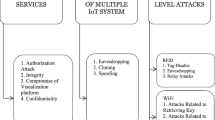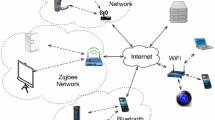Abstract
The Internet of Things (IoT) has been employed in a variety of critical fields, including healthcare, geriatric surveillance, self-driving vehicles, and energy management. The most prevalent infrastructure for these applications is Wireless Sensor Networks (WSNs). Although WSNs have intriguing characteristics, the security of such networks is a major concern, especially for applications where confidentiality is extremely crucial. In order to set up WSNs securely, any type of intrusion should be identified before attackers potentially harm the network. However, research findings have demonstrated that existing approaches are ineffective, particularly in detecting attacks in real-time, mostly owing to the accumulation of enormous amounts of data through interconnected devices. Within this interpretation, our intention is to construct a robust Intrusion Detection System (IDS) for analyzing real-time network traffic of WSNs using online learning algorithm while taking into account the network’s resource constraints. To achieve this goal, we investigated the use of an online classifier, namely the Hoeffding Adaptive Tree (HAT), along with the selection of relevant attributes to distinguish four kinds of DoS attacks among normal network traffic: the attacks considered are Blackhole, Grayhole, Flooding, and Scheduling attacks. Among the experimental findings, we determined that utilizing the HAT classifier along with the Chi-squared method of feature selection, detection rate percentages were 86.75%, 80.02%, 94.92%, 99.12% and 99.03% respectively for Flooding, Scheduling, Grayhole, Blackhole and normal case attacks. With an overall accuracy of 99.03%. Based on these findings, it is indeed possible to infer that the HAT classifier is extremely beneficial for categorizing attacks, as it has managed to secure a high detection rate despite the existence of many threats.
Access this chapter
Tax calculation will be finalised at checkout
Purchases are for personal use only
Similar content being viewed by others

References
Kumar, D.P., Amgoth, T., Annavarapu, C.S.R.: Machine learning algorithms for wireless sensor networks: a survey. Inf. Fusion 49, 1–25 (2019)
Kurniabudi, K., et al.: Network anomaly detection research: a survey. Indonesian J. Electrical Eng. Informat. (IJEEI) 7(1), 37–50 (2019)
Gupta, S.K., Sinha, P.: Overview of wireless sensor network: a survey. Telos 3.15\(\upmu \)W, 38mW (2014)
Hasan, S., Hussain, Z., Singh, R.K.: A survey of wireless sensor network. Int. J. of Emerg. Technol. and Adv. Engin 3.3, 487-492 (2013)
Chander, B.: Kumaravelan, One class SVMs outlier detection for wireless sensor networks in harsh environments: analysis. Int. J. Recent Technol. Eng. 7(4), 294–301 (2018)
Ifzarne, S., Hafidi, I., Idrissi, N.: Secure data collection for wireless sensor network. In: Ben Ahmed, M., Mellouli, S., Braganca, L., Anouar Abdelhakim, B., Bernadetta, K.A. (eds.) Emerging Trends in ICT for Sustainable Development. ASTI, pp. 241–248. Springer, Cham (2021). https://doi.org/10.1007/978-3-030-53440-0_26
Debar, H., Dacier, M., Wespi, A.: Towards a taxonomy of intrusion-detection systems. Comput. Netw. 31(8), 805–822 (1999)
Almomani, I., Al-Kasasbeh, B., Al-Akhras, M.: WSN-DS: a dataset for intrusion detection systems in wireless sensor networks. J. Sensors 2016 (2016)
Park, T., Cho, D., Kim, H.: An effective classification for DoS attacks in wireless sensor networks. In: 2018 Tenth International Conference on Ubiquitous and Future Networks (ICUFN). IEEE (2018)
Alqahtani, M., et al.: A genetic-based extreme gradient boosting model for detecting intrusions in wireless sensor networks. Sensors 19.20, 4383 (2019)
Chandre, P.R., Mahalle, P.N., Shinde, G.R.: Deep learning and machine learning techniques for intrusion detection and prevention in wireless sensor networks: comparative study and performance analysis, pp. 95–120. Singapore, Design frameworks for wireless networks. Springer (2020)
Dong, R.-H., Yan, H.-H., Zhang, Q.-Y.: An intrusion detection model for wireless sensor network based on information gain ratio and bagging algorithm. Int. J. Netw. Secur. 22(2), 218–230 (2020)
Ifzarne, S., et al.: Anomaly detection using machine learning techniques in wireless sensor networks. J. Phys.: Conf. Ser. vol. 1743, no. 1. IOP Publishing (2021)
Lohrasbinasab, I., et al.: From statistical-to machine learning-based network traffic prediction. Trans. Emerg. Telecommun. Technol. 33.4, e4394 (2022)
Lobo, J.L., et al.: Spiking neural networks and online learning: an overview and perspectives. Neural Netw. 121, 88–100 (2020)
Gama, J., et al.: A survey on concept drift adaptation. ACM Computing Surveys (CSUR) 46.4, 1--37 (2014)
Hoi, S.C.H., Wang, J., Zhao, P.: Libol: a library for online learning algorithms. J. Mach. Learn. Res. 15.1, 495 (2014)
Losing, V., Hammer, B., Wersing, H.: Incremental on-line learning: a review and comparison of state of the art algorithms. Neurocomputing 275, 1261–1274 (2018)
Tsymbal, Alexey: The problem of concept drift: definitions and related work. Computer Science Department, Trinity College Dublin 106(2), 58 (2004)
Rachburee, N., Punlumjeak, W.: A comparison of feature selection approach between greedy, IG-ratio, Chi-square, and mRMR in educational mining. In: 2015 7th international conference on information technology and electrical engineering (ICITEE). IEEE (2015)
Sreedevi, P., Venkateswarlu, S.: An efficient intra-cluster data aggregation and finding the best sink location in WSN using EEC-MA-PSOGA approach. Int. J. Commun. Syst. 35.8, e5110 (2022)
Author information
Authors and Affiliations
Corresponding author
Editor information
Editors and Affiliations
Rights and permissions
Copyright information
© 2023 The Author(s), under exclusive license to Springer Nature Switzerland AG
About this paper
Cite this paper
Tabbaa, H., Hafidi, I. (2023). An Online Model for Detecting Attacks in Wireless Sensor Networks. In: Aboutabit, N., Lazaar, M., Hafidi, I. (eds) Advances in Machine Intelligence and Computer Science Applications. ICMICSA 2022. Lecture Notes in Networks and Systems, vol 656. Springer, Cham. https://doi.org/10.1007/978-3-031-29313-9_24
Download citation
DOI: https://doi.org/10.1007/978-3-031-29313-9_24
Published:
Publisher Name: Springer, Cham
Print ISBN: 978-3-031-28845-6
Online ISBN: 978-3-031-29313-9
eBook Packages: Intelligent Technologies and RoboticsIntelligent Technologies and Robotics (R0)



